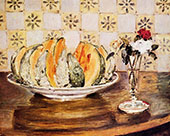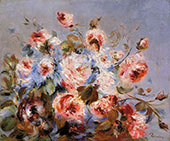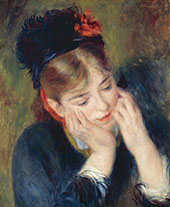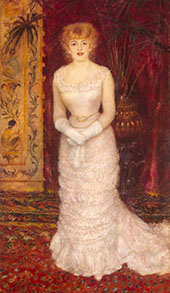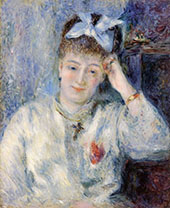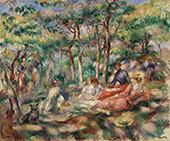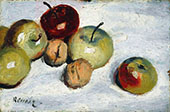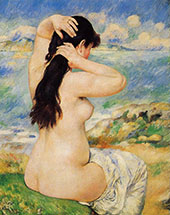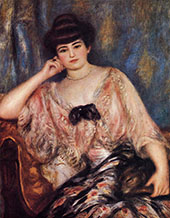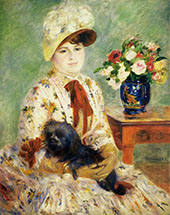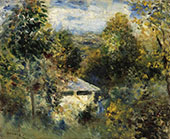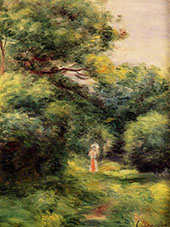Pierre Auguste Renoir Oil Painting Reproductions
Pierre Auguste Renoir replica paintings on Canvas for sale
Pierre Auguste Renoir Painting: An Artistic Biography
As a pioneer of French Impressionism, Pierre-Auguste Renoir transformed French art. His art is fascinating and beautiful and celebrates contemporary society and feminine sensuality. As the final representative of artistic tradition running from Rubens and Watteau, his paintings characterize turn-of-the-century Paris like no other.
But who was Pierre-Auguste Renoir, and what inspired his iconic works?
What kind of artist was Renoir?
Born on 25 February 1841 in Limoges, Renoir was a French Impressionist artist.
His father worked as a tailor, and the family moved to Paris in 1844. They lived near the Louvre art gallery, and from an early age, Renoir displayed artistic talent. Then, aged thirteen, he pursued an apprenticeship at a porcelain factory. Here, the owner spotted Renoir’s talent for drawing and informed his family.
Renoir enrolled at the Ecole des Beaux-Arts, supporting his studies through painting wall hangings for overseas missionaries. He also created decorations for fans. In 1862, Renoir studied under Charles Gleyre (a prominent Swiss artist). Here, he met Alfred Sisley, Claude Monet, and Frédéric Bazille.
Renoir struggled with poverty throughout his early years, often struggling to buy paint and other essentials. However, his first success came at the Paris Salon of 1868 with an artwork titled Lise with a Parasol (1867). This painting depicts his lover at the time, Lise Tréhot.
In these early years, Renoir often painted on the banks of the River Seine. He also painted at the countryside property of Jules Le Cœur. These two picturesque locations defined Renoir’s early output, seen in works such as The Fairies Pond (1866) and La Grenouillère (1869).
Why is Pierre-Auguste Renoir famous?
Pierre-Auguste Renoir is best known for his Impressionist oil paintings. Deeply inspired by the work of Camille Pissarro and Édouard Manet, he embodied impressionist ideals. Indeed, after several Salon rejections, Renoir worked alongside Pissarro, Sisley, and Claude Monet to launch the first Impressionist exhibition in 1874.
The six paintings Renoir exhibited were well received. However, Renoir primarily displayed portraits in the second Impressionist exhibition (1876). Hoping to secure lucrative portraiture commissions, he was sadly disappointed.
Renoir displayed a more comprehensive range of work at the third exhibition, including The Swing (1876) and Dance at Le Moulin de la Galette (1876). By the end of the 1870s, however, Renoir was a prosperous society painter. Success came after Madame Charpentier and her children's phenomenal critical acclaim (1878), shown at the Paris Salon of 1879.
What was Pierre-Auguste Renoir's style of painting?
Pierre Auguste Renoir painting is light, bright, and expressive. Frequently using dappled, quick brushstrokes, he sets contemporary figures against natural backgrounds, often featuring trees, sky, and water.
In paintings such as The Umbrellas, Renoir transforms a gray, rainy day into a light-filled scene. Despite the dark colors of the umbrellas and the people’s outfits, their faces shine with luminescent beauty.
In the 1880s, Renoir traveled to Algeria (inspired by Eugène Delacroix) and to Madrid to view the work of Diego Velázquez. He then visited Florence to view Titian’s masterpieces and Raphael paintings in Rome. Finally, meeting composer Richard Wagner in Sicily in 1882, Renoir painted his portrait in just 35 minutes.
In 1882 Renoir contracted pneumonia in1882. He recuperated in Algeria, but the illness permanently damaged his respiratory system. The following year, Renoir traveled to Guernsey (an Island in the English Channel), where he was astoundingly creative. Most of these artworks featured Moulin Huet, a beautiful bay in the Parish of Saint Martins.
Moving back to France, Renoir employed Suzanne Valadon as a model. She appears in (1884) and Dance at Bougival (1883). She also later became a leading painter in her own right.
Renoir married Aline Victorine Charigot in 1890. A seamstress (twenty years his junior), she also features in his most famous work, Luncheon of the Boating Party. They already had a child by this point, Pierre, born in 1885.
Renoir often painted his growing family in touching domestic scenes, such as Madame Renoir and Her Son Pierre (1890) and Claude Renoir, Playing.
How many Renoir paintings are there?
As an incredibly prolific artist, Renoir created several thousand oil paintings. As a result, auction sales exceed more than 4,000 Renoir oil paintings. The Barnes Foundation in Philadelphia holds the most extensive collection of Renoir artwork, with 181 individual paintings.
Renoir continued painting in later life. Unfortunately, he developed rheumatoid arthritis in 1892. This led Renoir to move to “Les Collettes”. A farm just outside of the village of Cagnes-sur-Mer in the Provence-Alpes-Côte d'Azur region, it was a beautiful setting.
Renoir continued painting despite progressive painful deformities in his hands and shoulders. He could barely grasp a paintbrush and often required help picking it up. However, works such as The Bathers (1919) show Renoir’s continued vibrant skill in later life. Renoir asked why he painted, even with painful arthritis, “the pain passes, but the beauty remains.”
He visited Paris one last time in 1919 to proudly view his paintings hanging amidst the Old Masters in the Louvre. Renoir died on 3 December 1919, at his home in Cagnes-sur-Mer.
Focus on: The Boating Party by Renoir
Amongst Renoir famous paintings, one artwork stands out: The Luncheon of the Boating Party. Given its mythical status in the history of impressionist art, here’s your essential guide to Renoir’s most iconic work.
Why did Renoir paint the Luncheon of the Boating Party?
Painted in 1881, The Boating Party by Renoir shows his inspiration from Italian Renaissance masters. He painted the work to explore color, light, and painterly technique in a contemporary setting.
Renoir particularly loved the work of Paolo Veronese. Indeed, the Luncheon of the Boating Party is highly reminiscent of Veronese’s The Wedding Feast at Cana (1563). Renoir brings impressionist sensibilities to a classical theme in a similar banquet setting.
What is the story behind the Luncheon of the Boating Party?
Luncheon of the Boating Party depicts Renoir’s friends relaxing on a balcony after a lengthy lunch. Combining the genres of still-life, landscape, and portraiture in one scene, it’s a unique and fascinating work.
Alphonse Fournaise Jr and Alphonsine Fournaise (siblings and children of the restaurant owner) are the only two figures prominent in the upper half of the painting.
What is the purpose of the Luncheon of the Boating Party?
Luncheon of the Boating Party shows Renoir’s Impressionist attempt to capture everyday life and light. Yet, even amongst Renoir artwork, it’s soaked in color. The primary light source comes from a large opening in the balcony, with dappled views of boats and the River Seine beyond.
Aside from this, the Luncheon of the Boating Party served no particular purpose. It wasn’t a commission or request. Nonetheless, it was incredibly well-received on its first display. Described as “fresh and free” and “one of the best things Renoir painted,” critics praised his juxtaposition of color and tone.
Who is the main character in Luncheon of the Boating Party?
There’s no central character in Luncheon of the Boating Party. Instead, the table (laden with grapes, empty glasses, and bottles) serves as the primary focal point.
Nonetheless, the main characters in the foreground include several close friends. The woman on the left (holding a small dog) is Aline Charigot. She features in many of his paintings as a dressmaker and Renoir's future wife.
Behind her stands Alphonse Fournaise (the restaurant owner’s son). Sitting opposite this pair (and backward on his chair) is the famous artist Gustave Caillebotte. He’s watched by Angèle Legault, with the Italian journalist Adrien Maggiolo behind her.
Which artist appears in Renoir's Luncheon of the Boating Party?
Gustave Caillebotte is the most celebrated artist in The Boating Party by Renoir. An influential Impressionist artist in his own right, Caillebotte also painted several famous works. The Floor Scrapers (1875) is his best-known painting today.
What was interesting about Renoir's painting Luncheon of the Boating Party?
On its exhibition at the Seventh Impressionist Exhibition of 1882, three critics voted Renoir’s Luncheon of the Boating Party the “best painting in the show.” The art-dealer Paul Durand-Ruel immediately bought the work from Renoir.
Nonetheless, not everyone was so impressed. Another commentator, Albert Wolff, wrote in Le Figaro that if Renoir “learned to draw,” he could have a “very pretty picture”!
In another interesting aspect, Aline Charigot (the woman with the dog and Renoir’s partner) only features because Renoir became annoyed with another woman previously sitting for the work.
Where is The Luncheon of the Boating Party located?
The Boating Party by Renoir depicts the Maison Fournaise restaurant. It was a particular favorite of artistic circles, set alongside the River Seine in Chatou, France (part of the affluent suburbs of Western Paris). This painting is one of our most popular reproductions of famous paintings.
Today, The Luncheon of the Boating Party appears at The Phillips Collection in Washington DC, USA.
Pierre Auguste Renoir Art: High-Quality Oil Paintings
If you love the beauty of art reproductions on canvas by Renoir, enjoy our extensive collection of Pierre Auguste Renoir art. As well to Renoir famous paintings, you’ll find thousands of oil paintings for sale.
Testimonial from Gregg S, Atlanta GA
Cannot Find What You Are Looking For?
Reproduction Gallery Information
Customer Service
(Send Us A Message)
Tel: (503) 937 2010
Fax: (503) 937 2011


